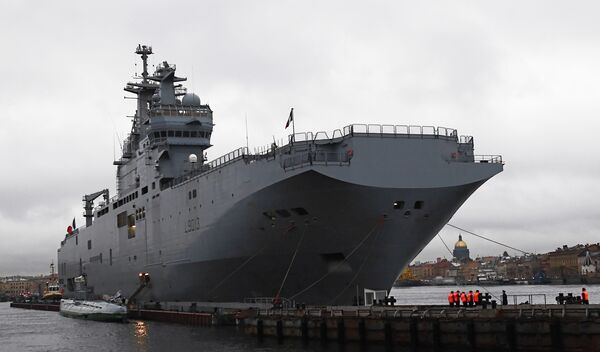The general purpose Mistral-class amphibious assault ship (LHA) has been officially declared the winner of a tender held by Russia's Defense Ministry, Chief of the General Staff Nikolai Makarov told reporters. No one expected any other result - the purchase of this Mistral-class LHA, licensed to be built in Russia, is more of a political move, part of the special Russia-France relationship, than it is a defense technology decision.
Long history
The issue of purchasing a Mistral-class LHA was first raised early in 2009. In fall 2010, the Defense Ministry opened a tender for just such a ship. Initially, the ministry planned to acquire one Mistral-class ship and then, with French assistance, to build three more at Russian yards under license. The final terms of this future contract are not being revealed as yet, but it is known that France put a different proposal on the table - two ships to be built at French yards and two in Russia.
The contract will be a definite landmark on the global arms market. First, because of its price - building four ships is set to cost over 1.5 billion euros, and, secondly, because Russia has, until now, been avoiding such large foreign military purchases, only sourcing components and technologies abroad.
One of the main reasons why the ministry turned to overseas suppliers is, many experts hold, the far from ideal condition of Russia's shipbuilding research, development and production sector, which, following the collapse seen in the 1990s and early 2000s, does not have the capacity to design and build ships in the required quantities on a fast turnaround. This situation can and must be remedied, but this remedy will take a long time, while time is the very thing that Russia's aging fleet lacks.
The overwhelming majority of ships in service are to be written off in the next 10 to 15 years, while the lead time for a new ship is no less than 10 years.
In some cases, Russia already has new projects for the construction of lead ships and is planning to launch series production. In this instance, however, Russia does not have a ready-made project for a ship of this class - Project 11780 was drawn up 25 years ago, has aged badly and is desperately in need of renovation. If this decision is made now, the earliest the navy will receive a lead ship will be 2020, while if the contract is concluded before yearend, a French ship could join the fleet as early as 2014. By 2020, one or two Russian-built ships would also be available.
Where will the Mistral serve?
It looks likely that the first ships of this class will be supplied to the Pacific fleet. The Defense Ministry also mentioned such plans, and reliable sources suggest that the basic infrastructure for these ships is under preparation in the Far East.
The deployment of this kind of vessel to the Pacific has every justification. The Asia-Pacific Region is increasingly becoming the focus of attention for the world's leading countries. It is the center of interests for such key players as Russia, the United States, China, Japan and India, because it concentrates the world's fastest developing economies and almost half the planet's population.
Clearly, naval theaters of operation, above all near Africa and South East Asia, will only gain in importance over the next few years as maritime trade, shelf development and fisheries all expand. The significance of oceans adjoining Russia is also set to increase - especially in the Far East, where the economic potential of local waters and shelf exists in close proximity with inter-governmental disputes - primarily over the Korean peninsula and regarding the Kuril Islands.
Stationed near the Kurils, a Mistral and similar ships could serve as a mobile base, providing effective support for troops stationed on remote islands. The equipment carried by a Mistral-class vessel can provide effective guidance to a disparate array of forces, even including ground units.
In addition, a Mistral-class ship can, like other ships in the same class, fulfill a wide range of other duties: from anti-piracy operations to search-and-rescue missions. A squadron of warships led by an LHA is capable of engaging in a low intensity localized conflict by landing troops and supporting them from the sea and air.
Not Mistral alone
The Mistral's value lies not so much in the ship itself as in the technology involved both in its construction and in upgrading Russia's shipbuilding by adopting new processes, equipment, etc. In this context, the clauses of the contract specifying the nature of French assistance take on particular weight. This assistance is described in some considerable detail, down to the precise number of workers and engineers to undergo training in France and the improvements to be made at shipyards selected to construct the Russian LHA.
According to the available information, St. Petersburg's Baltiisky Zavod (Baltic Shipyard) will build ships under French license. The Sevmash shipyard in Severodvinsk is overstretched as it is, and Russia has no other shipyards with the capacity to build ships of this size and displacement.
The purchase of a Mistral-class LHA seals the future of Baltiisky Zavod. It is clear that the construction of a series of LHAs rules out the relocation of the yard from Vasilyevsky Island to the other bank of the Neva River at least in the next ten years. In the long term, this issue is likely to be solved by upgrading.
The views expressed in this article are the author's and do not necessarily represent those of RIA Novosti.

